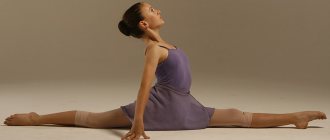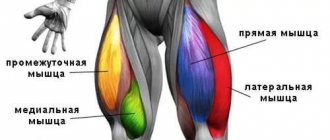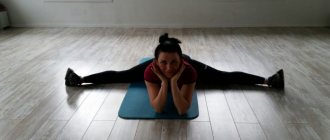© Aleksander — stock.adobe.com
Share:
Stretching is often associated in people with the ability to easily sit in longitudinal and transverse splits. These skills become a sign of athleticism, flexibility, and a healthy lifestyle.
A perfect split is a source of pride and envy. Training to improve the elasticity of ligaments does not have to be done in the gym. You can achieve good results at home.
Preparation
Before starting exercises to stretch muscles and ligaments, you need to warm up thoroughly. Neglecting a full warm-up can lead to injury. You should prepare your body within 20-30 minutes, do joint exercises, jog a little or jump rope, and perform a set of yoga asanas.
© fizkes - stock.adobe.com. One of the yoga asanas is downward-facing dog.
The sensations in the body should be light, it’s good if you feel warmth in the muscles. Sweating is another sign that your body is ready to stretch. However, you should not get tired during the warm-up. It is important to pay attention to breathing. It is necessary to ensure that it is deep and even, while the muscles are evenly saturated with oxygen.
Before stretching, you can go to the sauna or take a warm shower. For additional warming up of the ligaments, warm leggings or leggings are suitable.
What kind of twine is there?
Today there are several types of twine:
- The longitudinal version of the split is a simple type of split; if you are just learning how to do the splits, start with it.
- Transverse type of split - it is performed while sitting on the floor, legs spread in different directions and located on the same line.
- Sagging type of twine - it can be performed both on the basis of a transverse and on the basis of a longitudinal type of twine. Your hips can be in the air, and your legs can be on a support that rises above the floor.
- Vertical type of split - to perform it, you must stand on one leg and extend the other in the opposite direction. This type of twine can also be longitudinal or transverse.
- Handstand splits - different types of splits are performed in a handstand.
Split stretch for beginners
Flexibility depends not only on the level of initial training, but also on age and even on genetic characteristics. Do not despair if you are already over thirty and by nature the ligaments stretch poorly and take a long time. The desired result can be achieved with daily training, it will just take longer than at 16 years old.
There are requirements that need to be considered before you start reaching out.
Twine for beginners is:
- Mandatory thorough warm-up and warming up of all muscle groups, not just those on the legs. It is very important to prepare the entire musculoskeletal system for stretching, otherwise the risk of injury to the back, pelvis or shoulders increases.
- Smoothness and gradualness in training. Beginners should avoid jerking and putting too much pressure on the ligaments. Pain may be present, but should be tolerable on the verge of pleasant sensations. You cannot tolerate cutting and tearing sensations, or any unpleasant manifestations in the joints.
- Regularity of training. Each lesson brings the desired result closer. You need to exercise at least 3 times a week.
- Patience and perseverance will be needed to get the splits for those who are naturally inflexible or have never done stretching. There is no need to recklessly wait for an instant result, only to be disappointed and quit when you don’t get it.
A good motivation will be a diary of achievements in which progress will be noted. If it is there, it means that the training is being carried out effectively and you will definitely be able to do the splits.
Twine at home
When you have completed all the exercises, we begin to try to sit on the longitudinal splits, in which one leg is placed in front of the other. To do this, you need to try to sit lower with springy and light movements, while keeping your legs straight. To sit in a cross split, you need to place your legs shoulder-width apart and try to put your elbows on the floor, while using springy movements you need to lower your pelvis to the floor as low as possible. You need to increase the load gradually, and most importantly smoothly. If you are already about 30 years old or more, then in order to do the splits it will take at least a year, and for this, at each subsequent workout you need to increase your stretching and try to lower your pelvis as low as possible.
Safety rules for self-training
Stretching exercises at home without the supervision of an experienced trainer require increased attention to safety rules. The pursuit of quick results can lead to serious injuries to ligaments and muscles and make further training impossible. You should treat your body with love and care and give it time to adapt.
So, everyone who wants to achieve the perfect split on their own needs to remember the following important things.
Duration
It is unlikely that you will be able to do the splits in a week or even a month if you have never had a good stretch before. Systematic exercises, perseverance and attention to sensations will help prepare the muscles, ligaments and joints well enough. To avoid tears and painful sprains, you need to carefully “listen” to your own feelings, avoid overload, do not set yourself any deadlines, and try to enjoy the process. It's important to praise yourself for your progress and keep pushing.
Warm-up
Warm-up is always necessary. A little exercise on all muscle groups, joints and ligaments will help avoid pain and injury. Don't move on to stretching too quickly. The better the preparation, the more enjoyable and productive the path to the splits will be.
Schedule
The schedule of training days is compiled individually. It depends on the goals you set for yourself. A full stretching session lasts about an hour, including warm-up. For good dynamics, three high-quality workouts per week are enough.
You can alternate them with strength or cardio exercises. On those days when full stretching is not carried out, it is enough to simply warm up the ligaments a little with a light warm-up or perform several yoga complexes. This will help avoid muscle pain.
Technique and rules
Beginners need to avoid sudden jerks, swings and dismounts. Each exercise is performed smoothly with competent and thoughtful load distribution.
To progress, a sprain must go through nagging, tolerable pain.
You can't hold your breath. On the contrary, it is better to breathe deeply, concentrating the effort on exhalation.
While performing the exercise, all attention is concentrated on the sensations in the body; it is important to “hear” yourself and stop in time.
Types of stretching
There are two main types of stretching: static and dynamic. With static exercises, the exercises are aimed specifically at sitting in the splits. Dynamic is a leg swing in which the split is achieved by moving the leg up or sideways. Some people find dynamic stretching easier, while others, on the contrary, achieve results faster in the static version.
For effective training, both types should be combined.
When trying to sit in a longitudinal or transverse split, do not simply statically pull the ligaments. It will be much more effective if you perform light rocking movements with a short amplitude.
Cloth
Clothing should not restrict movement or interfere with the work of ligaments and muscles. It's a good idea to wear socks or slip-on shoes so that your feet can easily move apart and pull under their own weight.
© fizkes — stock.adobe.com
Time control
To control your workout time, it is convenient to use special applications for smartphones or a simple timer to alternate exercises and at the same time pay sufficient attention to each one. Feeling pain and discomfort, many quickly finish and move on to what is easier. In this case, you will have to wait a very long time for the twine.
Nutrition
Adjustments to your diet will help you do the splits more quickly. Consuming enough water, omega-3 fats and collagen has a positive effect on tissue elasticity.
Tips and tricks
There are some more simple tips for those who want to do the splits:
- To properly stretch the ligaments, especially those located under the knees, the feet should be held towards you, and not extended.
- When performing exercises, your back and shoulders should be straight. If this doesn’t work, it’s better to take additional equipment, such as bricks or chairs. If your knees or back begin to hurt while stretching, it means that your technique is broken and the load is distributed unevenly.
- The most productive time for stretching is the morning. However, at the very beginning of training, it is better to do it in the late afternoon, since by this time the body is more warmed up due to natural movements during the day.
- It is better to refuse assistance in stretching from strangers. Only a trainer with knowledge of anatomy and physiology knows how to properly dose the load. Awkward movements can cause injury.
Benefits of stretching
- First of all, it improves a man's sexual health. Due to the fact that during exercise, blood flows abundantly to the groin area, potency improves. This promotes physical and mental health.
- Well-warmed muscles are more resilient. This means that any workout will be much more effective if you stretch well before it.
- Reduces the risk of injury and damage. This applies to stretching not only before training, but also before any physical activity.
Did you know? The more flexible and prepared the muscles, the easier it is for the body to cope with lifting weights, carrying loads, and even just long-term sedentary work.
All about the twine
If you have never been able to do the splits before, then don’t despair, absolutely anyone can do the splits from scratch. It doesn’t matter whether you are an adult or a young person, whether you played sports or not. Everyone is made up of muscles and our muscles are very elastic. You can always stretch them, the main thing is to do it correctly. And you shouldn’t look at others to see what someone can do faster or slower. We are all different and each has our own abilities.
However, before starting training, you need to prepare carefully so that there are no injuries and these trainings do not harm you.
There are several types. Transverse - legs are placed in opposite directions. Longitudinal - one leg is extended forward, and the other is extended back. Thus, the longitudinal one can be left-sided or right-sided, it all depends on which leg is put forward.
You should also know that there is gymnastic and pop twine. Their difference is that gymnasts have their hips turned out during the longitudinal movement, while dancers have them looking straight. So we can say that dancers have better stretching for the splits than gymnasts.
What's the difference you ask? Gymnastics is much simpler, try it yourself and you will feel the difference.
There is also a sagging split when you sit down from an elevated position, but you shouldn’t do it right away, first you need to learn the classic one. Vertical split - one leg stands on the floor, and the other rises up, resulting in one straight line.
If you perform a stretching routine for a month, then after a while you will see noticeable results. Read on and find out how to stretch correctly, how often and what stretching exercises you need to do to do the splits.
Stretching methods for girls from 14 to 25 years old
At this age, you can see results in a week or less if you do just a few exercises regularly. It is recommended to repeat the following complex 3 times a day for 5-10 minutes. You need to start with a warm-up. This can include walking in place, light jogging, bending to the sides and forward, and jumping in place. After a short warm-up, you can begin the main exercises.
1. From a standing position, extend one leg forward, bending it at the knee. The second limb is laid back and rests on the toe on the floor. The leg that is located in front should be bent at an angle of 90 degrees. The knee does not extend beyond the shin. Hands up or on your belt. You need to stay in this position for as long as possible. Beginners only need 30-60 seconds. Then repeat the same thing, but on the other leg. This exercise allows you to stretch the longitudinal twine.
2. Warrior pose is a tendon stretching exercise. To do this, you need to kneel and place your palms on the floor. Legs are bent. Then you need to spread your knees as far as possible, feeling the tension. He should rest on outstretched arms or elbows. Rounding the back is not recommended. Stay in this position for a minute. Beginners can place soft pillows under their knees to prevent pain.
3. The frog pose for stretching the splits should be done with care. The following exercise will also help stretch the cross split. You should squat down with your knees wide apart. The elbows should rest on them, the palms should be joined together. The buttocks look down, the pelvis gradually opens. Stay in this position for 30-60 seconds.
4. The pose for opening the pelvis allows you to prepare the cross split. This exercise is effective for stretching your hamstrings. You need to sit up straight with your legs extended forward. Socks should be pulled up. Bend over, trying to touch your stomach and sternum to your knees. Hold for 30 seconds. Take a short break and repeat.
5. Leg Bend Over Helps Stretch Your Hamstrings
After each exercise, it is recommended to rest and take a break for 1 minute.











